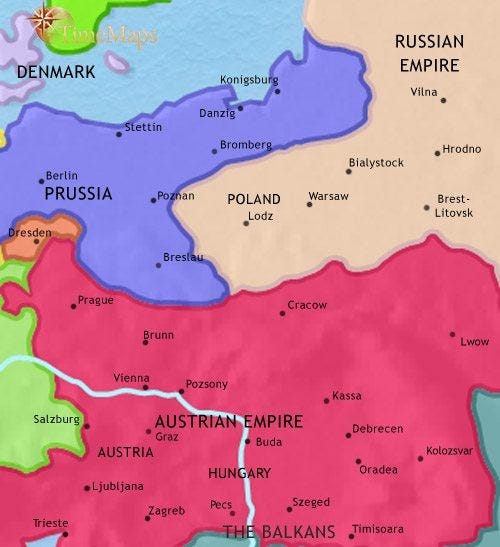The Rise of Balkan Nationalism — Part 1
Contents
Introduction
The First and Second Serbian Uprising
The Wallachian Uprising of 1821
The Rebirth of Greece — Greek War of Independence — Treaty of Adrianople
Albanian National Awakening (1830–1839)
Bosnian Uprisings (1831–1833, 1834, 1836)
Other Wars Outside Ottoman Territory
Concluding Remarks
Bitesize Edition
The Ottomans were in decline, and superpowers surrounding them were seeking to control and influence the empire. The empire was showing weakness on a global stage but was also breaking down from within.
The Russians were supporting many of these uprisings, starting with the First Serbian Uprising, closely followed by the Second. The first saw the Serbs gain de-facto independence. The second saw them lose it. But the seeds were sewn amongst the Balkans.
Another region impacted by the Russo-Turkish War of 1806–1812 was Wallachia. This marked the rise of Romanian nationalism. The Greek War of Independence saw the first success of a state that gained independence. The Treaty of Adrianople also saw Serbia and Romanian principalities gain semi-autonomy.
The trend is clear. Ottoman weakness is providing a platform for these nations we now know in the present day, to rise up and feel represented. There are plenty more examples of this occurring throughout the 19th century. Find out more below.
Introduction
It was clear during the Russo-Turkish War of 1806–1812 that the Ottomans were clinging to the power they possessed at the time. When an empire collapses, it can be challenged by a rising power. This is the idea behind Thucydides Trap. But what occurs when an empire collapses from within? The disadvantage of seeking to control one huge bloc is if a culture or previously existing nation feels unrepresented when the opportunity to revolt, rebel, or rise presents itself, they will likely take it. Many countries in the Balkans took such an opportunity in a period known as the Rise of Balkan Nationalism in the 19th century, starting with the First Serbian Uprising.
The First and Second Serbian Uprising
Occurring between 1804 and 1813, the first Serbian uprising coincided with the Russo-Turkish War of 1806–1812, and was actively supported by the Russians, and initially Wallachia in 1804. Initially, it was a revolt against the Dahjie who took control of Serbian territory in a coup in 1801, but eventually, it transitioned into a war for independence, as did many of these uprisings.
In their first attempt, they were unsuccessful. However, the Serbs were the first to give it a go. This set the seeds for an entire century of uprisings. In 1813, the Ottomans managed to re-annex Serbia after existing as a de-facto independent state during the first uprising.
The seeds set in the first uprising blossomed to life in the Second uprising commencing in 1815. This saw a better result in the eyes of the Serbs, who received some independence when the Principality of Serbia was established, which saw the establishment of a Serbian parliament, constitution, and royal dynasty.
Photo by Dimitrije Milenkovic on Unsplash
The Wallachian Uprising of 1821
In the aftermath of the Russo-Turkish War (1806–1812), the Russians controlled parts of Moldavia and renamed it Bessarabia. However, Wallachia still existed as an Ottoman vassal state. In 1821, the Wallachia uprising began against the Phanariots, who were members of Greek families who were the royal family of Wallachia. Initially, this uprising wasn’t targeted against the Ottoman’s rule over the Balkans, but it did begin a period of Romanian nationalism, as did many of these uprisings.
The Rebirth of Greece — Greek War of Independence — Treaty of Adrianople
Also occurring in 1821 was the Greek War of Independence. The Greeks were supported by many revolutionaries within the Balkans, including the Serbians and Romanians, as well as the Russians, French, and British.
This led to a naval exchange between an Ottoman-Egyptian fleet and those of the Russians, British, and French. The Ottoman-Egyptian fleet was destroyed in the Battle of Navarino, and the tide turned in favour of the Greeks.
This was an independence attempt against the Ottoman Empire, lasting until 1829, and it was a successful attempt. The rule established by the Ottomans in the 15th century (excluding the Ionian Islands) had come to an end.
The Treaty of Adrianople granted the Greeks autonomy and granted Serbia and Romanian principalities semi-autonomy.
 Figure 1 — https://timemaps.com/history/greece-1837ad/
Figure 1 — https://timemaps.com/history/greece-1837ad/
 Figure 2 — https://timemaps.com/history/poland-czech-hungary-1837ad/
Figure 2 — https://timemaps.com/history/poland-czech-hungary-1837ad/
Albanian National Awakening (1830–1839)
The attempts of the Ottomans to suppress nationalism under the territory it controlled also failed with the rise in Albanian nationalism starting in the 1830s. From 1787 until 1822, the Albanian Pashaliks were ruling over Albania with de-facto independence, although this wasn’t officially accepted by the Ottomans. Ali Pasha, leader between 1787 and 1822, was eventually assassinated by Ottoman agents. Over the following years, any leaders, named the Albanian beys, saw their power fade. The Massacre of the Albanian Beys occurred in 1830 and saw 500 Albanian leaders killed by Ottoman forces.
This is dubbed as the spark that lit the fire of the Albanian National Awakening. Having seen Greece gain autonomy, and Serbia and the Romanian principalities gain semi-autonomy, the trend was clear. Those who were challenging the rule of the Ottomans were finding success, with the support of those larger powers (Russia, Britain, France).
The Massacre of the Albanian Beys saw a planned alliance between Albania and Bosnia end. But the Bosnian’s hope for autonomy didn’t stop there.
In Albania’s case, revolts against the Ottoman’s new centralised policy occurred between 1833 and 1839, including uprisings in Shkoder and Tepelene in 1833. These uprisings continued as the Ottomans made promises to the Albanians that they usually reversed in a play to attempt to maintain the power that was seeping through their fingers.
Photo by Elion Jashari on Unsplash
Bosnian Uprisings (1831–1833, 1834, 1836)
Bosnia’s first uprising against the Ottoman Sultan Mahmud 2nd saw them defeated in 1832. It was another example of the Sultan’s centralisation process of authority in the Ottoman region that was rejected by those seeking greater national representation. As a result of the rebellion, in 1833, the Eyalet of Herzegovina was created from the southern territory previously of the Eyalet of Bosnia. This only lasted until 1851 when Ali Agha Rizvanbegovic, the leader of the territory, was executed by the Ottomans.
Other rebellions occurred after the Balkan defeat, with the Priest Jovica Rebellion and the Second Masici Rebellion, both in 1834. The Posavina Rebellion occurred in 1836.
Other Wars Outside Ottoman Territory:
Ottoman-Persian War (1821–1823) — To the south, the Ottoman-Persian War of 1821–1823 saw a Persian victory. This ended with the Treaty of Erzurum, which recognised the borders established in 1639’s Treaty of Zuhab. Interestingly, this treaty was the first time both the Ottomans and Persians agreed to send an envoy to each other’s country every three years.
Russo-Turkish War (1828–1829) — As a consequence of the Greek War of Independence and Russian involvement in the Battle of Navarino, the Ottomans closed the Dardanelles to Russian ships. It was part of the Treaty of Adrianople that ended this conflict and saw the Russians further occupy the Danubian Principalities, which consisted of Wallachia and Moldavia.
 Figure 3 — Russo-Turkish War (1828–1829). (2024, April 12). In Wikipedia. https://en.wikipedia.org/wiki/Russo-Turkish_War_(1828%E2%80%931829)
Figure 3 — Russo-Turkish War (1828–1829). (2024, April 12). In Wikipedia. https://en.wikipedia.org/wiki/Russo-Turkish_War_(1828%E2%80%931829)
Egyptian-Ottoman War (1831–1833) (1839–1841) — In the aftermath of the Greek War of Independence, the Egyptian de-facto leader Muhammad Ali Pasha wanted a reward for supporting the Ottomans. The reward the Egyptians wanted was control of Greater Syria. It was the loss during the Battle of Navarino that saw Muhammad Ali Pasha’s son, Ibrahim Pasha, lead the Egyptians in their moves against Syria. They took Acre by May 1832, before advancing to and eventually controlling Aleppo, Homs, Beirut, Sidon, Tripoli, and Damascus. They headed into Anatolia in late 1832, with the Battle of Konya marking the extent of their progress. The Egyptians, despite having a smaller army, won once again in this battle. It was only an unexpected alliance between the Ottomans and Russia that limited Ibrahim’s army. The British and French were worried this marked the Russians’ increased power in the declining Ottoman Empire, and so forced the Egyptians into the Convention of Kutahya. This saw Syria ceded to Egypt, and Egypt became an autonomous vassal of the Ottoman Empire. Muhammad Ali Pasha sought to declare de jure independence in 1839. He was declared a traitor, and the Second Egyptian-Ottoman War began. The Ottomans were once again defeated by the Egyptians in the Battle of Nezib. The Ottoman Sultan, Mahmud 2nd, died a few days later and left his 16-year-old son in charge. The Ottoman Empire looked on the way to collapse. However, the Brits, Russians, and Austrians pledged support for the weakening Ottomans. Muhammad Ali was forced to withdraw from Syria. This conflict saw the British occupation of Beirut and Acre in 1840 and eventually saw the Egyptians abandon claims to Syria. The Ottomans were once again in control of Syria, as well as Crete and the Hejaz. It was clear at this point, that the Ottomans weren’t in the driver’s seat in determining their own future. They were easily controllable by larger powers, and easily defeated in war. This contributed to the rise of nationalism from within the Ottoman Empire and the increased involvement of the British, French, Russians, and Austrians in events unfolding in the territory of the Ottoman Empire. They were still referred to as an empire at this point but showed very few characteristics that actually represented an empire at the peak of its powers.
Photo by Mo Gabrail on Unsplash
Concluding Remarks
Next week, we’ll finish coverage on the rise of Balkan nationalism in the 1800s, before exploring the Balkan Wars and heading into the World Wars. We’ll soon be back in the present day, where we’ll explore the conflict between Serbia and Kosovo.
Other News
Israeli Foreign Minister: Erdogan Sacrifices Economic Interests In Order To Support Hamas
Turkey Restricts Export of Some Products To Israel Over Gaza Invasion
Nuclear Industry Wants Canada To Lift Ban On Reprocessing Plutonium
Half of The Rural Hospitals In The United States Are Operating At A Loss
California Supreme Court To Review Rooftop Solar Net Metering
World’s Biggest Economies Providing Poorer Countries With Funding For Fossil Fuels
Thanks for reading! If you want more then subscribe on Substack for these posts directly to your email inbox. I research history, geopolitics, and financial markets to understand the world and the people around us. If any of my work helps you be more prepared and ease your mind, that’s great. If you like what you read please share with others.
Key Links
The Geopolitics Explained Podcast
Sources:
https://en.wikipedia.org/wiki/Greek_War_of_Independence#:~:text=The%20Greek%20War%20of%20Independence,Empire%20between%201821%20and%201829.
https://historica.fandom.com/wiki/Albanian_rebellions_against_the_Ottoman_Empire#:~:text=The%20Albanian%20rebellions%20against%20the,the%20independent%20Principality%20of%20Albania.
https://en.wikipedia.org/wiki/Albanian_resistance_to_the_Ottoman_Empire
https://en.wikipedia.org/wiki/Rise_of_nationalism_in_the_Ottoman_Empire
https://en.wikipedia.org/wiki/Albanian_revolts_of_1833%E2%80%931839
https://en.wikipedia.org/wiki/Bosnian_uprising_(1831%E2%80%931832)
https://en.wikipedia.org/wiki/Rebellions_in_Bosnia_and_Herzegovina



